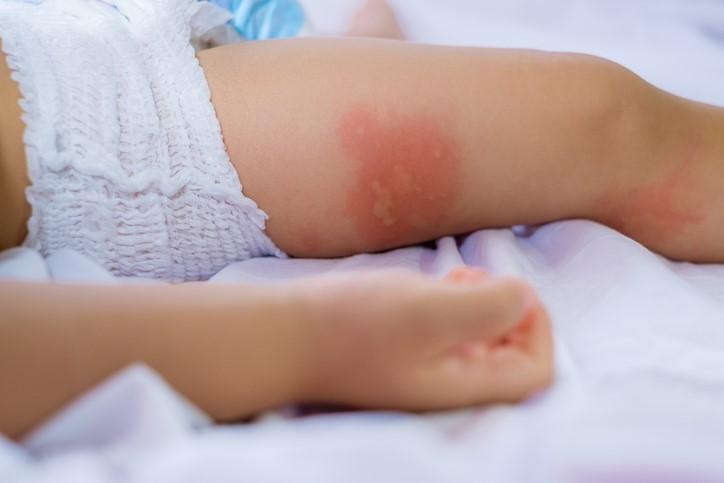Researchers with the Centers for Disease Control and Prevention (CDC) have found that children taking antibiotics visit US emergency rooms nearly 70,000 times a year with an adverse reaction, with young children most at risk.
In a study today in the Journal of the Pediatric Infectious Diseases Society, researchers with the CDC's Division of Healthcare Quality and Promotion report that, from 2011 through 2015, an estimated 69,464 emergency department (ED) visits were made annually by children aged 19 and younger for adverse drug events (ADEs) caused by antibiotics. That number accounts for nearly half (46.2%) of all ED visits for ADEs from medication in this age-group.
Just over 40% of the ED visits involved a child 2 years old or younger.
The vast majority of the visits (86.1%) involved an allergic reaction to an antibiotic, mainly mild reactions like rashes or itchy skin but also including more severe reactions such as anaphylaxis or angioedema, in which swelling occurs in the area beneath the skin. Other ADEs included diarrhea or stomach upset.
While short-term adverse reactions to antibiotics in children are known to be a common cause of ED visits, the researchers say they wanted to quantify the current risk to help clinicians and parents weigh the risks and benefits of antibiotics, which are among the most commonly prescribed medications in US children.
"We knew that this was a problem, and it was more about understanding the magnitude of the problem today," co-author Katherine Fleming-Dutra, MD, told CIDRAP News. "These data really highlight the importance of always weighing the risks and benefits of antibiotics before a clinician prescribes them."
Fleming-Dutra also noted that the numbers could be an underestimate, since the study didn't account for adverse events reported in other settings, or not reported at all. "There were probably many more for which families either didn't seek care or saw a doctor in an office," she said.
Risks higher for young children
The researchers came up with their estimate of using data from an ADE surveillance project based on a nationally representative sample of hospitals, and from national estimates of oral antibiotic prescriptions dispensed from retail pharmacies. The cases included ED visits that the treating clinician attributed to the use of a systemic antibiotic.
More than 95% of the ED visits for antibiotic ADEs involved a patient on a single antibiotic, mainly oral antibiotics. Amoxicillin, which is commonly prescribed in children for conditions such as acute ear infections, was the most frequently implicated antibiotic in children aged 9 and younger, while sulfamethoxazole/trimethoprim was the most common cause of adverse events in children 10 to 19 years old.
After accounting for prescribing frequency, the researchers calculated that, for all antibiotics except sulfamethoxazole/trimethoprim, the risk of an ED visit for an antibiotic ADE was higher for young children than for older children. The rate of ED visits for adverse reactions to amoxicillin, for example, was four times higher for children 2 years and younger than for 10- to 19-year-olds. Fleming-Dutra said there are a number of reasons for this, including the fact that younger children get more antibiotics than older children and are more susceptible to allergic reactions to antibiotics. But she also suggested that parents are more likely to react to an adverse event in a young child.
"It is certainly possible that parents of young children are more concerned when something happens to a young child," she said. "They may perceive them to be more vulnerable and have a different threshold to bring that child in than they might have for an older child."
Data could aid stewardship efforts
Whatever the reason, Fleming-Dutra and her colleagues suggest that having these data on antibiotic ADEs in children, and knowing that young children in particular are at greatest risk, could possibly reduce unnecessary antibiotic prescribing. Even though the study did not determine whether the antibiotic prescriptions were appropriate, national data from 2010 to 2011 indicate that 29% of outpatient pediatric antibiotic prescriptions were unnecessary.
And while the threat of antibiotic resistance is a strong public health message for reducing unnecessary antibiotic use, it may not be enough dissuade an anxious parent from seeking an antibiotic for a sick child who may not need one. Knowing how often antibiotics can result in clinically significant adverse reactions could change the conversation between parents and clinicians.
"Making these number more known to clinicians, who are making the decision whether to prescribe antibiotics, and helping patients understand that these medications do have harms, and that we have to carefully weigh the risks and benefits, is a really important stewardship strategy," she said.
"Of course we're very concerned about driving antibiotic resistance, but for the patient, I think it's very helpful talk about the benefit that they may or may not receive from taking a particular antibiotic, versus the risks that they are facing."
Fleming-Dutra said going forward, the data from the study will likely be used in the CDC's efforts to promote awareness of antibiotic resistance and improve antibiotic prescribing.
See also:
Aug 23 J Pediatric Infect Dis Soc study






















